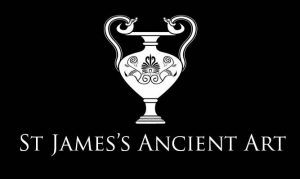Symeon was a 6th century saint, born in Antioch in AD 521, close to the border of Syria. Syria was home to large numbers of stylites, ascetics who lived on platforms atop of columns, including the first stylite, Symeon Stylites the Elder (ca. 389–459). The younger saint ascended his first pillar at the tender age of seven. In 541, Symeon moved to another pillar located on the ‘Wondrous Mountain’ or ‘Thaumaton Oros’ (Θαυματόν Ὄρος). The mountain was so named after the abundance of miracles that took place, mostly attributed to the saint. Symeon ended his life on the Wondrous Mountain in 592. The mountain and subsequent monastery that arose functioned as a pilgrimage site until the arrival of the Arabs and experienced a revival during the Byzantine reoccupation of the area from 969 to 1074. Tokens such as this were available for pilgrims to collect at large, religiously important sites as a keepsake. They were made from the earth available around the shrine or pilgrim site and were collected for their apotropaic properties, as well as a precious momento. Possessing such token of the Empire was not only a spiritual blessing and souvenir for the pilgrim, but also a ‘get-home-free’ pass to prove one’s Orthodoxy should one find oneself detained by imperial troops, at the time when Byzantine Empire was still fiercely persecuting and murdering Monophysite Christians.
Byzantine Terracotta Pilgrim’s Token of Saint Symeon the Stylite
£ 400.00
A very fine, large terracotta pilgrim token of Symeon the Stylite, most likely the Younger. The token is circular in shape with a domed back and irregular edges depicting in the centre a stylite saint atop a pillar, or ‘style’. The term comes from the greek word ‘στῦλος’ (stylos), meaning ‘column’ or ‘pillar’. Two angels carrying crosses are visible on either side of the saint. The curving ladder leaning against the column on the right serves as a visual representation of his connection to the Earth and his disciples. Two nimbate figures are depicted at the base of the pillar, on either side of it. It’s possible that the two figures are the saint’s disciple, Conon, and his mother Martha. A granulated frame surrounds the image. The obverse is undecorated but features fingerprint impressions, reflecting the handcrafted nature of the token.
Provenance: Collection of Biblical antiquities of a London gentleman
Condition: Very fine condition. Some wear to the surface. Earthy encrustation throughout.
| Weight | 11.5 g |
|---|---|
| Dimensions | W 3 cm |
| Christian Ideology | New Testament |
| Pottery | Terracotta |
| Region | Near East (Western Asiatic), Southern Europe |
Reference: For similar: The Baltimore Museum of Art, US, item 1940.32.39








